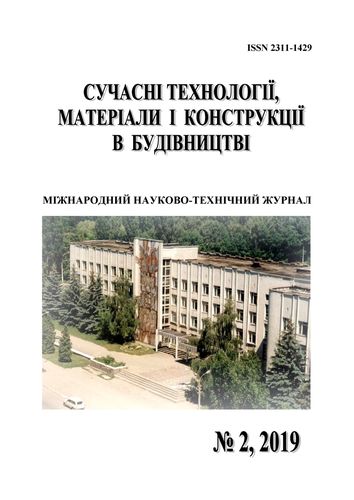ДОСВІД ВИКОНАННЯ ҐРУНТОЦЕМЕНТНИХ ЕЛЕМЕНТІВ ПО ТЕХНОЛОГІЇ СТРУМЕНЕВОЇ ЦЕМЕНТАЦІЇ В ШЛАК ДОМЕННОГО ВИРОБНИЦТВА
DOI:
https://doi.org/10.31649/2311-1429-2019-2-87-95Ключові слова:
технологія струменевої цементації, струменево-цементаційна колона, шлаки доменного виробництва, ґрунтоцементний матеріалАнотація
У статті розглянуто перший в Україні досвід виконання ґрунтоцементних колон в шлаках доменного виробництва.
Відповідно до проекту підсилення ґрунтової основи при реконструкції приміщення з навісом в станцію з виробництва продуктів розділення повітря з установкою ВРУ-1400 в м. Єнакієве на території заводу були виконані експериментальні роботи з метою підтвердження правильності обраних технологічних параметрів струменевої цементації (Jet Grouting) у фактичних інженерно-геологічних умовах будівельного майданчика і контролю геометричних і міцнісних параметрів ґрунтоцементних колон.
Виконано дві дослідні ґрунтоцементні колони, виконано візуальне та інструментальне обстеження джет-колон, висвердлені керни з тіла джет-колони в горизонтальному напрямку і випробування матеріалу на міцність на стиск, а також відбір кернів у вертикальному напрямку на всю довжину джет-колони, випробування ґрунтоцементного матеріалу і підтвердження цілістності виконаної джет-колони.
За результатами візуального обстеження була підтверджена циліндрична форма струменево-цементаційних елементів і заміряні фактичні діаметри, які склали 610 ... 640 мм, що більше від необхідного за проектом - 600 мм.
Відібраний вертикальний керн підтверджує проектну довжину джет-колони, суцільність тіла джет-колони і відсутність розривів при обробці ґрунту високонапірним струменем цементного розчину.
За результатами лабораторних випробувань цементно-шлакових циліндрів, відібраних з горизонтальних кернів міцність матеріалу склала від 4,76 до 7,68 МПа для віку 24 діб і 7,96 МПа для 28 діб. За результатами випробувань циліндрів з вертикального керна мінімальна міцність цементно-шлакового матеріалу склала 7,3 МПа, максимальна – 11,2 МПа. Отримані результати міцності на стиск ґрунтоцементного матеріалу перевищують проектну міцність рівну 2,5 МПа.
В результаті проведених дослідних робіт на майданчику будівництва ВРУ-1400 по виконанню ґрунтоцементних колон було підтверджено правильність технічного рішення щодо вибору технології Jet Grouting для підсилення ґрунтів основи в складних інженерно-геологічних умовах, а саме насипних шлаках доменного виробництва.
Посилання
A.L. Shagin, Yu.V. Bondarenko, D.F. Goncharenko, Reconstruction of buildings and structures. Study Guide for Builds. specialist. universities. Moscow, Russia: Higher School, 1991, 352 pp.
P.A. Konovalov, Basements and foundations of reconstructed buildings. Moscow, Russia, 2000, 308 pp.
N.A. Tsytovich, V.G. Berezantsev, B.I. Dalmatov, Basements and foundations. Moscow, Russia: Higher School, 1970, 384 pp.
P. Croce, A. Flora, G. Modoni., Jet Grouting. Technology, Design and Control. NW: SRS Press Taylor & Francis Group, 2014, p. 9.
I.I. Broyd, Jet Grouting Geotechnology: A Training Manual. Moscow, Russia: Publishing House of the Association of Building Universities, 2004, pp. 71-124.
##submission.downloads##
-
PDF (English)
Завантажень: 174
Опубліковано
Як цитувати
Номер
Розділ
Ліцензія

Ця робота ліцензується відповідно до Creative Commons Attribution 4.0 International License.


